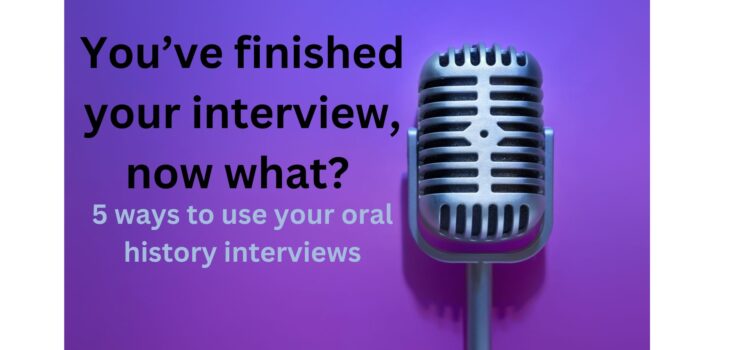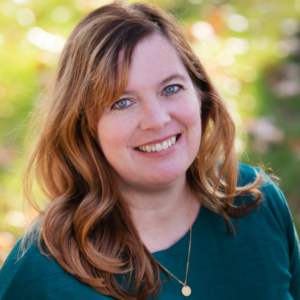
You’ve conquered the big task of completing your first oral history interview; now what should you do with the audio file, video, and transcripts? Maybe it was an interview you did of yourself of or of a loved one. Maybe you paid someone to interview or a friend or family member. Here at Evalogue.Life, I have found that many people are wondering what to do with the interview once it’s complete, so I thought it was high time to share some ideas. These tips are tried and true methods of making the most of your oral history interviews.
1. Enjoy the interview as-is
One of the first and best tips I can offer is to just enjoy the interview as is. You don’t HAVE to “do” anything with the recording except maybe share it. Of course, I will talk about other options, but it’s okay to stick with the basics. You have a priceless treasure of pure, unfiltered voice to share with family and friends. I do most of my oral history interview via zoom and so not only do I have access to an oral recording, I also have access to the video recording as well as the transcript zoom provides.
Making the most of transcripts:
Through Zoom, you can “view transcript” of the interview as you go and I like to do that so I can see if the transcript is adequate for me to use. If I am not satisfied with that I can run it through a third-party web-based program like HappyScribe or Otter AI. However, I have found that the Zoom transcription gives me a lovely and accurate record, sometimes better than those third party programs and definitely less pricey. With the Zoom recording, you have a couple of versions of the transcript, the audio and the MP4 video recording.
Be sure to save and back up the interview files
As soon as I complete the interview I upload the recording to the cloud (I prefer Dropbox or Google Drive) so I have it backed up somewhere other than Zoom, and then I can decide what is next. When the recording is uploaded to the cloud, it is shareable. You can choose to share directly from the cloud by creating a shareable link or sharing the drive itself.
Quick tip: All of these methods can also be used if you are using a digital audio recorder or recorder app on your phone.
I prefer using Zoom for my interviews these days because I find the sound to be superior, and having the video attachment is a bonus. Whether you use Zoom, a digital recorder, or a voice recorder app, the same methods and tips apply.
In summary, enjoying the as-is audio/video recording is a priceless treasure in and of itself. Sharing with family and friends is enjoyable, and whatever you have today is more than you had yesterday. And if you’ve only done one interview that is okay too. However, I would suggest doing more than one to capture a full life story.
Related article: 12 tips to record voice – edit, save, and transcribe audio
2. Edit your recording
Editing audio is not generally a service we offer at Evalogue.Life, but it can be done. It is a bit labor-intensive but possible if you are looking for some parts to be edited out.
Audacity for editing audio:
One way to edit the audio is with the free, open-source program, Audacity. It is robust software, but it does take some time.
Adobe Premiere Pro or iMovie
I have recently been working with Adobe Premiere Pro and it does a nice job of editing as well as iMovie. This is an app that comes with Apple products and is Apple friendly, but cannot be used easily with Android products. Both Adobe and iMovie edit the video – not just audio – and it works nicely. As I mentioned before, these programs take quite a bit of time and patience, but some people really enjoy the editing process. Because it is time-consuming, hiring someone to do this editing work can be expensive. I personally like the authenticity of the original recording because it captures the way people.
TwistedWave is easier software for editing audio
Another software program that is more user-friendly than Audacity is TwistedWave. Here is a video tutorial on it by our founder, Rhonda Lauritzen.
3. Create a video from the audio
I have had a few of my clients create videos with snippets from their interviews. Since each interview can last between 25 and 50 minutes, I don’t advise creating a video including pictures and b-roll for the full length of the interview. I would suggest taking snippets – maybe a great vignette or story from the interview and creating a video with that. It can be between 2 and 10 minutes long (I wouldn’t suggest surpassing 10 minutes) and you can fill in the recording with pictures in the background and some b-roll video if you have it or want to create it.
You may even interview someone to just a capture a particular story and want to create an eye-catching video to go with it. I would suggest using programs such as Animoto, Adobe Premiere Pro, iMovie, Adobe Spark or even Canva has some video-making capabilities now.
Free versions of video software for oral history interviews
Animoto, iMovie and Adobe Spark all have free versions that will give you basic tools to create a video, but the paid versions will give you much bigger and better options. Rhonda Lauritzen and I have taught a class on using Animoto and there are many tutorials out there for these programs. I would also suggest grabbing a young person in your life to help you. They were born knowing how to use this technology and it can be a fun process to work with them and share a few stories in the process.
Gathering photos, videos and storyboarding your vignette for your video is a great idea to do at the start and all of these programs have storyboards built into their programs. This is a fun process, but it, as with many other projects of the nature, are time consuming and require some patience. But I think you will find that you love the project in the end. The other perk of creating a series of short videos to go with your oral history interviews is that people of all ages will be pulled into watching the stories unfold – another of those priceless treasures.
Related article: How to storyboard
4. Hire a Coach, Ask a Friend or Find a Writing Group to Create a Book
One of my favorite things to do with oral history recordings is to turn them into a page-turning book. I am currently working on several books for clients to turn those interviews into books, but I love it when my clients decide to tackle the project on their own and let me help them or work with a writing group or friend to make it happen. There is much satisfaction that comes from doing your own writing and it is more cost-effective.
How does a writing coach help?
There are writing coaches like me who would love to help you make your writing what you want it be or working with a writing group can also be magic. Rhonda Lauritzen and I can help you find a writing group or you can be part of one of our professional groups. There are other local groups in your neighborhood that you can find by contacting your local library or social media. With this method you can work at your own pace and feel a great sense of accomplishment upon completion. Make sure you create a timeline, outline or storyboard (I often use all three) to get yourself started and use it as a guide as you write. If you choose not to use a coach, I would suggest meeting with someone at the start to help you get on your feet or on your way. You may not need someone’s help regularly, but may just need an occasional meeting to boost your creativity, bounce ideas off of or help keep you motivated.
5. Write a Book or Hire Someone to Write a Book
While using the transcripts can be sufficient, there is nothing like creating a beautiful book with your oral history recordings. I do this often for clients (as mentioned above) and I have had a few of my oral history clients tackle this on their own. It is a wonderful idea and creates a tangible heirloom for your family and friends to enjoy for eons of time.
If money is not a question for you, hiring someone to write your book (especially if they have conducted the interviews) is a great option. It does take time – often much longer than you think – so be prepared for that. There are different types of books you can request – a hardbound book, spiral-bound 8-1/2 x 11 size, digital book, etc. You will work closely with the author on exactly what you want and what the timeline will be. Oftentimes, the timeline is a little longer than you think it will be at first, but it will be worth it in the end.
If you choose to do it yourself, be gentle with yourself, but also be consistent. I would suggest still finding a writing group and a trusted group of friends to edit your work and give advice. Hiring someone or doing it yourself is a rewarding process.
These are our favorite tips and tricks for tackling and using your oral history interviews. The biggest tip I can offer is for you to share them, whatever product you have in the end. There are many people in your or your loved one’s life that will treasure the voice, the video and the experience.

Rachel has been telling stories since she could walk and talk. As a little girl, she would draw for hours and make up stories to go along with her artwork. Before coming to Evalogue.Life, she worked as a newspaper reporter for 17 years at Ogden’s local newspaper, The Standard-Examiner. She reported on heavy topics ranging from heated city elections to local school issues. But her love for writing about people’s life stories and their triumphs over tragedy captured her heart.
She loves family storytelling. A graduate of Weber State University, she has had articles featured on LDSLiving.com, lds.org, FamilySearch.org and Meridian Magazine. She has been a speaker at RootsTech, Weber State University Family History Conference, Conference on Family History at BYU and the Southern California Genealogy Jamboree. She helps people tell and write their life stories and has written six life stories with several more in production. She has also helped several others write their own stories. She and her husband Mat have six children and she recently became a grandma! She and her family live on the East Bench in Ogden, Utah.
